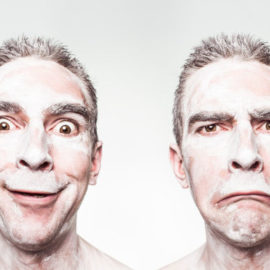

This article gives you a glimpse of what you can learn with Shortform. Shortform has the world’s best guides to 1000+ nonfiction books, plus other resources to help you accelerate your learning.
Want to learn faster and get smarter? Sign up for a free trial here .
What does Brené Brown have to say about shame? What’s the solution to feeling shame?
In many of her books, author and researcher Brené Brown explains why we feel shame, why it’s harmful, and how to rise from it. All of her research combines into a meaningful discussion on human emotions that you can use to develop your self-worth.
Taking advice from four of her books, we’ll look at what is said by Brené Brown on shame and how to combat it.
What Is Shame?
According to Daring Greatly by Brené Brown, shame is the fear of not being worthy of connection and belonging. It is the fear that you are not enough and will be rejected for your weaknesses. It overtakes the prefrontal cortex and initiates your fight or flight response. Instead of being able to think critically or analyze the legitimacy of a threat, you are thrust into survival mode.
Once the shame cycle begins, you really only have three options: fight, freeze, or run. In terms of human behavior, this might look like aggression, numbing, or people pleasing. Being in this type of survival mode prevents you from connecting meaningfully with yourself and others, which impedes your ability to live wholeheartedly.
Categories of Shame
Brené Brown’s shame research identified 12 categories that fall under three core themes of shame.
Body Image and Health
- Mental and physical health: Fear of not having a fit enough body, not being strong enough, not being smart enough, and so on.
- Addiction: Fear of never feeling happy enough, alive enough, or peaceful enough.
- Sex: Fear of unworthiness, or fear of being ugly.
- Aging: Fear of no longer being loved and admired for looks, or fear of mental deterioration.
- Appearance and body image: Fear of not having the right weight, the right make-up, clothes, and so on.
Relationships
- Motherhood or Fatherhood: Fear of being unprepared or unable to identify with the role of mother or father.
- Parenting: Fear of not being a good enough parent, not nurturing enough, or not respectable enough.
- Family: Fear of judgment, fear of loss, fear of not being stable enough, and so on.
- Surviving trauma: Fear of not being safe, not being worthy of love, or not being connected enough.
- Religion: Fear of not being a good enough person, or fear of punishment.
Social Status
- Money and work: Fear of not having enough money, being criticized in front of coworkers, having to file for unemployment, and so on.
- Being stereotyped or labeled: Fear of not being fully seen, or fear of judgment.
Where Does Shame Come From?
Shame often develops in childhood and lingers throughout adulthood. The roots of shame are often built at home or school as a result of interactions with authority figures such as teachers or parents. For example, if a teacher calls a student “stupid” in front of the class for forgetting to put their name on their paper, that student may develop shame around their intelligence.
One study showed that 85% of people feel the impact of being shamed in school. Of those people, half of them were shamed for their creativity (or lack thereof). This has caused many to avoid creativity well into their adult years, causing what many in the business world are calling an “innovation crisis.”
In addition to negative interactions with teachers and parents, Brené Brown’s book The Power of Vulnerability says that negative interactions with siblings often cause shame. Siblings know each other’s triggers and often abuse that knowledge through name-calling, physical abuse, and other cruel practices. These often occur during fights and are usually outlets for unrelated anger.
For example, if Johnny had a rough day at school, and his sister, Kelly, makes a joke at his expense, Johnny may make a cruel comment about Kelly’s appearance in retaliation. If self-image is something that Kelly struggles with, this comment could feed into her shame and drive her deeper into her insecurity.
Shame Triggers
Shame triggers are topics that evoke emotional responses based on your insecurities. These triggers are often the result of your upbringing and can elicit one of three negative responses:
- Silence: You say nothing and internalize your feelings. This leads to disconnection as you shut yourself off emotionally.
- Complacency: You people-please and overcompensate to pretend that nothing’s wrong. This causes disappointment as you succumb to the pressures of others.
- Aggression: You lash out and, often, shame other people in retaliation. This perpetuates and exacerbates shame culture.
For example, if you feel insecure about your body, and someone makes an off-hand comment about someone’s weight, you may feel an emotional response to their comment, leading you to do one of the following:
- You walk away and dive into your work. When people ask you what’s wrong, you say nothing. (Silence)
- You overcompensate by also making fun of the person your colleague was talking about. Later, you feel disappointed for commenting on someone else’s weight. (Complacency)
- You tell your colleague to back off, then comment on their appearance. Your colleague feels shamed and takes it out on someone else. (Aggression)
These triggers are often developed in childhood but carry on into adulthood. For example, if you were raised to believe that laziness is unacceptable, you may view taking breaks or getting sick as unacceptable because they keep you from working. This may cause you to make unhealthy decisions and overwork yourself to avoid your shame.
How Shame Regresses Self-Development
To further illustrate what’s said by Brené Brown on shame, we’ll dive into how she says the emotion prevents you from reaching your fullest potential. Here we’ll look at the self-destructive behaviors Brown states shame causes.
Shame Prevents You From Developing Worthiness
Worthiness is the conviction that you are good enough as you are. According to The Gifts of Imperfection, worthiness is underpinned by four key principles:
- Accepting yourself unconditionally. You don’t need to hit a milestone to become worthy—for example, losing a certain amount of weight. You’re enough right now.
- Rejecting the idea that to be “enough,” you need to adhere to societal norms or the expectations of others. You’re worthy as you are, regardless of what anyone else thinks.
- Abandoning the idea that you need to work for your worthiness. You don’t need to prove yourself to be “enough.” Your worth is based on who you are, not what you do.
- Believing that you’re worthy of love and belonging. If you don’t, you won’t be able to truly experience these emotions.
The greatest barrier to developing worthiness is shame. Shame prevents worthiness from growing because it tells you that you’ll never be good enough. It encourages you to reject and hide the parts of yourself that you think other people will dislike. It also convinces you that if you do reveal your flaws and struggles, they’ll come to define you. People will focus on your bad parts and ignore everything good about you.
Shame Causes Fear, Blame, and Disconnection
According to Brown’s I Thought It Was Just Me (But It Isn’t), when we allow shame to consume our mind, it also produces three feelings that cause harm to our health, happiness, and relationships: 1) fear, 2) blame, and 3) disconnection.
Outcome #1: Fear
Shame causes fear because being associated with identities we disdain makes us afraid that we’re unworthy of love and connection. In other words, we fear that others won’t want anything to do with us if they associate us with that identity. For example, someone who feels shame over being unimportant fears that this identity will make them a lesser person whom others don’t want to associate with.
Brown says our fears (the identities we disdain) usually develop due to societal expectations and the expectations of our inner circle—friends, family, peers, bosses, and so on. Societal expectations have historically caused many non-conventional identities to become disdained and a point of shame. Similarly, your inner circle might have caused you to see “creativity” as a disdained identity if you grew up in a family that looked down on artistic expression.
Outcome #2: Blame
Shame also leads to anger and blame. This is because experiencing anger and assigning blame allows us to expel the negative emotion of shame. Anger replaces the painful feeling of shame, and assigning blame allows us to direct that anger either inward or outward. Brown argues that blame in any form is unproductive because it expels negative feelings without addressing its root cause and inspiring change.
When we direct our anger inward, we blame ourselves for being defective in some way and ultimately deserving the shameful experience. For example, if someone makes you feel unattractive, you might escape the feeling of shame by directing your anger inward and blaming yourself for being foolish enough to ever believe that you were attractive. Blaming yourself overrides the feeling of shame by inducing self-hatred and self-pity instead.
When we direct our anger outward, we blame others for being unjust and feel better by believing that we didn’t deserve the shameful experience. For example, if someone makes you feel unimportant, you may escape shame by directing your anger outward and blaming the other person for being pompous.
Outcome #3: Disconnection
Finally, Brown notes that shame causes disconnection from ourselves and others when we allow it to control our thoughts, feelings, and behaviors—when it makes us feel afraid and angry and causes us to assign blame. There are three ways that the effects of shame cause disconnection:
1) Our fear, inward anger, and blame cause us to intentionally disconnect from others (emotionally or physically) to hide our shameful identities. You might avoid social events and end up disconnected from friends and peers.
2) Our fear, outward anger, and outward blame cause us to unintentionally disconnect from others. For example, someone who feels shame over being unimportant might outwardly direct anger and blame by getting defensive and asserting superiority over anyone who threatens them. This aggression might cause them to unintentionally disconnect by making others dislike and avoid them.
3) Our fear of being associated with identities we disdain makes us pretend to be someone we’re not, disconnecting us from ourselves. For example, someone who feels shame over being seen as “nerdy” might give up certain “nerdy” passions in favor of activities that seem “cool.” This can disconnect them from their true identity and confuse who they really are and what’s truly important to them.
The Solution to Shame
Based on research in I Thought It Was Just Me (But It Isn’t), empathy is the solution to shame. Brené Brown defines empathy as using our own experiences to understand others’ thoughts, feelings, and behaviors from their perspectives without judgment.
While we can’t entirely avoid experiences of shame, Brown says that strengthening our ability to empathize with both ourselves and others makes us less reactive to shame and combats the feelings of fear, blame, and disconnection that shame causes.
There are three main practices that Brown recommends you integrate into your daily life:
- Acknowledge your shame and what causes it. Recognizing your shame and its causes will allow you to separate from your negative thoughts and emotions before they can cause you to experience fear, react with blame, and become disconnected from yourself and others. Acknowledging your shame will enable you to practice courage, compassion, and connection.
- Develop critical awareness of shame. Critical awareness is an understanding of why we deem certain identities as shameful, how shame around these identities impacts society, who’s most affected by the shame of identities, and who benefits the most from them. To develop critical awareness about shame, think of an identity that makes you feel ashamed. Which components of this shameful identity contradict society’s or your inner circle’s expectations? Then, think of the ideal you feel like you’re supposed to be living up to instead, and consider its impact on society at large: Who suffers because of this ideal’s existence, and who profits from it?
- Learn to talk about shame and connect with others. We connect with others by sharing experiences and establishing mutual support. This is crucial to combating shame because it facilitates the empathy element of connection, which helps you put courage and compassion into action. Further, once you learn how to express your own shame and ask for support, you’ll be better equipped to listen to others and support them.
Final Words
Brené Brown has spent most of her life’s work studying shame’s impact on humans. Thanks to her research, we have a good understanding of how to challenge shame. Now it’s time for you to take these practices and apply them to your life.
Do you agree with Brené Brown on shame? Let us know in the comments below!

Want to fast-track your learning? With Shortform, you’ll gain insights you won't find anywhere else .
Here's what you’ll get when you sign up for Shortform :
- Complicated ideas explained in simple and concise ways
- Smart analysis that connects what you’re reading to other key concepts
- Writing with zero fluff because we know how important your time is






